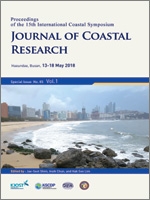Ni X.; Huang S.; Feng W., and Yao W., 2018. Numerical simulation of tidal bores using SPH method. In: Shim, J.-S.; Chun, I., and Lim, H.S. (eds.), Proceedings from the International Coastal Symposium (ICS) 2018 (Busan, Republic of Korea). Journal of Coastal Research, Special Issue No. 85, pp. 951–956. Coconut Creek (Florida), ISSN 0749-0208.
A tidal bore is a natural hydraulic phenomenon normally formed in funnel-shaped estuaries with large tidal ranges. Water levels and flow velocities change rapidly in both magnitude and direction when a tidal bore arrives. These strongly nonlinear water body movements have significant influences on scouring and deposition processes along the riverbed and produce hydrodynamic impacts on piers and dikes. In this paper, a mesh-free numerical method known as the smoothed particle hydrodynamics (SPH) method is used to implement a numerical model capable of handling complex free-surface flows and solve the Navier-Stokes equations with a large-eddy simulation. A tidal bore generation scheme suited for a mesh-free numerical method is also proposed based on the SPH open boundary technique. Various types of tidal bores, including undular bores, weakly breaking bores and breaking bores, are simulated and validated with measured data. The numerical results represent the evolutionary processes and hydrodynamic characteristics of tidal bores ranging from weak to strong intensities. The generation and evolution of dipole substructures in breaking tidal bores are also discussed. By studying the bed shear stresses and depth-averaged vorticities of the tidal bores, it can be concluded that the sediment incipience intensity grows nonlinearly in the second order with an increase in the tidal bore intensity, while the sediment transportation intensity grows linearly.





